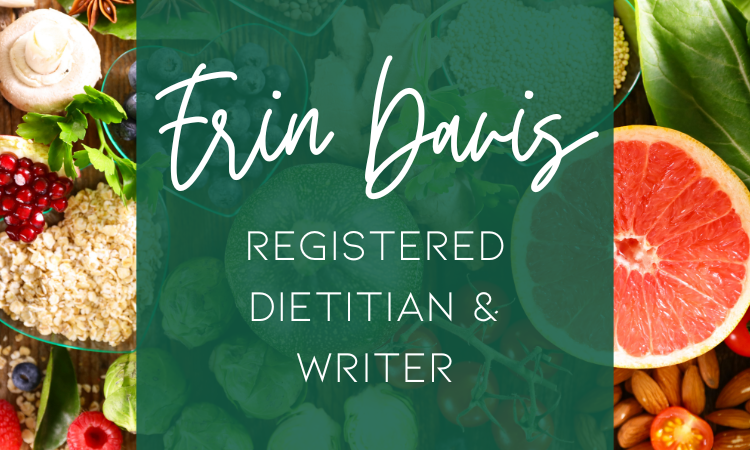You’ve been diagnosed with gestational diabetes, told to avoid carbs, watch what you eat and exercise, and sent home. Sound familiar?
Many women experience a range of emotions upon a gestational diabetes diagnosis. You might be feeling guilty upon diagnosis, confused about next steps, or frustrated from the lack of advice you have received. You might also view this as a wake-up call, wanting to take action for you and your baby.
It can feel like there are a lot of unknowns during this time. You may have received very vague guidance upon your gestational diabetes diagnosis or have a gap in between meeting with a dietitian or diabetes educator. Many common questions and concerns begin to arise in your period of waiting and wondering:
- What can I actually eat?
- Do I have to severely restrict my carbs?
- How do I adjust my diet?
- How can I get healthier without hurting my baby?
Intuitive eating might be the answer to all of these concerns. It prioritizes you and your baby and brings hope and clarity to your situation.
Not only does intuitive eating allow you to enjoy the foods you love without the stress of dieting, but intuitive eating has been found to reduce blood sugars and risk of depression and anxiety.
In today’s post, you’ll learn all about intuitive eating for gestational diabetes.
- Intuitive Eating: The Basics
- Managing the Overwhelm
- Gestational Diabetes Basics: Blood Sugar
- Intuitive Eating for Gestational Diabetes
- Honoring Your Cravings
- What to Eat for Breakfast with Gestational Diabetes
- Enjoying Desserts with Gestational Diabetes
- Ordering Fast Food with Gestational Diabetes
- Meet with a Dietitian who Specializes in Gestational Diabetes
- Key Points
- References
Please note: As an Amazon Associate, I earn from qualifying purchases.
Intuitive Eating: The Basics
Intuitive eating for diabetes is a non-diet approach that emphasizes managing your blood sugars while listening to your hunger cues, eating often, and eating a variety of foods.
So how does intuitive eating help manage gestational diabetes?
By learning your body’s signals and how to satisfy your needs, intuitive eating can instill confidence in your pregnancy.
Essentially, you eat when you’re hungry and stop when you are full. You eat foods that nourish your body and promote a healthy pregnancy, but you also include foods that bring you joy…like chocolate.
Does it sound too easy, or good to be true? It’s actually been proven to be a successful way to manage gestational diabetes.
When women with gestational diabetes eat intuitively during pregnancy, they gain less weight, have better blood sugars, and improved mood.
Having to diet can be overwhelming. Up next is how intuitive eating can help counteract those feelings.
Managing the Overwhelm

There can be many emotions associated with gestational diabetes. When it comes to managing it, some women emphasize the word “control”.
Control resonates with many women amid learning how to handle their diagnosis. Gestational diabetes can seem overwhelming at first, but intuitive eating is a great place to start. You let your body tell you what you need.
Understanding what gestational diabetes is, how to manage it, and what you have control over shows that you can manage your health.
Gestational Diabetes Basics: Blood Sugar

Gestational diabetes is caused by the combination of some increased hormone levels during pregnancy acting on insulin levels. Insulin is a hormone that helps you manage your blood sugar.
Ultimately, gestational diabetes creates insulin resistance. That means your body will not break down and use sugar as easily as it normally would.
You’re likely checking your blood sugar before you’ve eaten and 1-2 hours after meals. To reduce the risk of complications, the goal is to stay within the targets:
- Fasting: <95 mg/dL
- 1 hour after a meal: <140 mg/dL
- 2 hours after a meal: <120 mg/dL
Balancing blood sugar levels shouldn’t feel stressful. However, you want to have the best outcomes for you and your baby.
Contrary to popular belief, you DO NOT have to give up all carbs. Fortunately, there are some basic ways you can manage your levels throughout the day.
Intuitive Eating for Gestational Diabetes

In general, it is important to eat a variety of foods with gestational diabetes. This ensures that you and your baby are getting all of the nutrients that you need.
It’s important not to cut anything out- even carbs. Carbs are important for fiber. Fiber has numerous health benefits such as helping blood sugar levels, heart health, and helps you feel more full.
Fruits, veggies, and whole grains (like oats) are good sources of low glycemic index carbs which means they won’t spike your blood sugar.
One way to combat frequent blood sugar spikes in gestational diabetes is to eat more frequent meals throughout the day. This might look like eating 5-6 times a day instead of just 3. This involves listening to your hunger cues and eating until you are satisfied, avoiding overeating at each meal.
Spreading out carbs throughout the day can help balance blood sugar levels. Consider eating smaller amounts of carbs at each meal instead of large amounts in one sitting.
Eating protein with carbs can also balance out your blood sugar levels. Some sources of protein include nuts, meat, eggs, dairy products like yogurt or cheese, or seeds.
Other trends to note are that blood sugar levels sometimes spike in the morning with gestational diabetes, so think about shifting your timing around eating carbs.
For example, instead of grabbing the cereal right away in the morning, you might first have a yogurt parfait with your favorite fruit and some granola topping. A bowl of cereal or some oatmeal might be better enjoyed later in the day.
As mentioned above, protein is also beneficial for balancing carbs and blood sugar. In addition to this, protein is key for growth of the baby.
Exercise can be just as important for fueling your body during pregnancy. With gestational diabetes, exercise after eating could help manage your blood sugar levels. Think about your favorite way to get moving. This could look like walking, cycling, doing yoga, or even swimming throughout the day.
Each person is different when it comes to listening to their own cues and acting on their hunger. That is why individual eating plans are key while managing blood sugar levels, food preferences, exercise, and work and leisure schedules which intuitive eating can account for.
Honoring Your Cravings

Another important part of intuitive eating is to honor your pregnancy cravings.
You notice your blood sugar levels spiking, but you’re craving carbs. What now?
Consider a smaller portion of your craving paired with another nutrient-dense food or some simple swaps. For example:
- A small bowl of cereal with some nuts and cheese on the side.
- A peanut butter and jelly made with whole wheat bread.
- Consider whole wheat noodles or zucchini noodles instead of white pasta.
- Opt for apple nachos (apples with peanut butter, chocolate, or any other topping of choice).
Mindful eating is key! Remove distractions and pay close attention to how your desired food looks, tastes, and smells. Here are some mindful eating exercises to help you better enjoy your food.
What to Eat for Breakfast with Gestational Diabetes
If you find your blood sugar spiking in the morning, save the carbs for your next meal. Try these breakfast options:
- Greek yogurt with fruit and chia or hemp seeds
- Veggie-packed omelet
- Berry smoothie with protein powder
- Hard boiled eggs with fruit on the side
- Overnight oats
Enjoying Desserts with Gestational Diabetes
Have a sweet tooth? Try some simple swaps to make desserts more gestational diabetes-friendly:
- Desserts like crumbles have lots of hidden nutrients like berries and oats.
- Choose whole wheat flour when making a dessert.
- Try fruit purees for dessert toppings or sorbet for a fruity treat.
- Dark chocolate
- Homemade bark such as frozen bananas drizzled with peanut butter and dark chocolate
Give these delicious desserts a try!
Ordering Fast Food with Gestational Diabetes
You may be wondering if you can have fast food with gestational diabetes. The answer is YES!
When the fast food cravings hit, here are some tips to keep in mind for your next order.
- Consider grilled options over fried like a grilled chicken sandwich or grilled nuggets.
- Opt for a whole wheat bread option- whole wheat bun for a sandwich or burger, or whole wheat bread for a sub. Another alternative is to eat less bread such as using half of the bun instead of the whole.
- Choose a bowl or salad option.
- Consider your drink choices- could you choose water? Any unsweetened beverages such as tea?
- Choose thin crust pizza instead of deep dish.
Check this post out for more options when fast food dining!
Meet with a Dietitian who Specializes in Gestational Diabetes
Lastly, please don’t feel like you have to figure it out on your own. There are diabetes educators specialize in pregnancy.
During an appointment with an educator/dietitian, your blood sugars will be reviewed and we can make tweaks to your food intake that don’t feel restrictive.
The good news is that dietitian visits are often covered 100% with gestational diabetes.
If you would like to put your mind at ease, learn how you can eat to nourish your baby without dieting, and want to have healthy pregnancy, Erin can help. We can work through the process of intuitive eating for gestational diabetes together.
Erin has worked with many pregnant woman newly diagnosed with gestational diabetes over her 20-year career and is accepting new clients through Nourish.
Click on the button to see if your insurance covers a registered dietitian and diabetes educator and to book with Erin.
Key Points
- Intuitive eating for gestational diabetes is an all-inclusive eating plan that prioritizes listening to your body and eating to fuel you and your baby.
- Gestational diabetes might have increased blood sugar spikes in the morning so spacing out carb intakes throughout the day can be beneficial.
- Intuitive eating honors pregnancy cravings. If blood sugar levels would not be supported by a specific craving, fast food, or dessert, consider making some swaps or portion adjustments to work with your blood sugar.
- You can have improved outcomes like better blood sugars, lower risk of depression and anxiety, and more optimal weight gain with intuitive eating for gestational diabetes.
References
- Gao XX, Zheng QX, Chen XQ, et al. Intuitive eating was associated with anxiety, depression, pregnancy weight and blood glucose in women with gestational diabetes mellitus: a prospective longitudinal study. Front Nutr. 2024;11:1409025. Published 2024 Jul 25. doi:10.3389/fnut.2024.1409025
- Karavasileiadou S, Almegwely W, Alanazi A, Alyami H, Chatzimichailidou S. Self-management and self-efficacy of women with gestational diabetes mellitus: a systematic review. Glob Health Action. 2022;15(1):2087298. doi:10.1080/16549716.2022.2087298
- Rasmussen L, Christensen ML, Poulsen CW, et al. Effect of high versus low carbohydrate intake in the morning on glycemic variability and glycemic control measured by continuous blood glucose monitoring in women with gestational diabetes mellitus-A randomized crossover study. Nutrients. 2020;12(2):475. February 13, 2020. doi:10.3390/nu12020475
- Dingena CF, Holmes MJ, Campbell MD, Cade JE, Scott EM, Zulyniak MA. Observational assessments of the relationship of dietary and pharmacological treatment on continuous measures of dysglycemia over 24 hours in women with gestational diabetes. Front Endocrinol (Lausanne). 2023;14:1065985. January 26, 2023. doi:10.3389/fendo.2023.1065985
- Reynolds AN, Akerman AP, Mann J. Dietary fibre and whole grains in diabetes management: Systematic review and meta-analyses. PLoS Med. 2020;17(3):e1003053. Published 2020 Mar 6. doi:10.1371/journal.pmed.1003053
About the author
Morgan is a Clinical Dietetics and Applied Food and Nutrition major at Grand Valley State University. She loves learning how to keep nutritious food fun. Her interests currently lie in functional nutrition counseling, but she is excited to see where the rest of her education will lead her. In her spare time, she enjoys traveling, spending time with friends and family, cooking, and being outdoors. She looks forward to becoming a registered dietitian and helping others form positive relationships with food.


